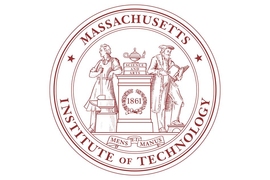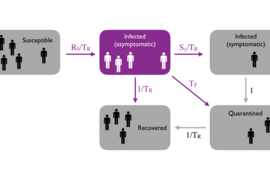As MIT continues to consider and refine options for the fall, two questions stand out: how to safely and responsibly welcome people back into the Institute’s physical spaces, and how to ensure the MIT community can excel and thrive during what will likely be an extended and ongoing pandemic.
While several groups work to answer those questions, MIT has also begun to collect data to inform a return to campus. A residence hall study launched earlier this spring has helped MIT researchers understand the prevalence of Covid-19 on campus. And an operational system currently in development builds on the success of that study, with an eye toward limiting the virus’s spread.
Residence hall study
In early April, MIT Medical and the MIT Institute for Medical Engineering and Science (IMES) invited all students remaining in MIT residences and on-campus residential life support staff to take voluntary weekly tests, including temperature and oxygen measurements and a nasal swab administered by licensed clinical staff. Two hundred and forty students and staff signed up and remain active in the study. Anyone who tests positive is moved to a separate living area for isolation and treatment.
“Understanding the prevalence of Covid-19 in our community and the rate of transmission within our dorms are critical pieces of information that can help inform how living areas should look and operate whenever students return to campus,” says MIT Medical Director Cecilia Stuopis, who shaped the effort and has overseen its implementation.
The study, which was approved by MIT’s Committee on the Use of Humans as Experimental Subjects (COUHES), has sought to advance epidemiologic understanding of the virus while promoting the safety and health of MIT’s campus community.
“The approach we are taking is classic MIT,” says Elazer Edelman, who is the study’s principal investigator, a physician, and director of IMES. “Create a hypothesis — that opening MIT is safe — and test it with an experiment using emerging innovations. Starting with a limited campus rollout, we are examining progressive phases of population expansion, placing greater stress on the hypothesis until we arrive at a way to reach our ultimate goal: a safe reinvention of the MIT campus in the Covid-19 era.”
MIT Covid-19 response system
The residence hall study paved the way for the nascent MIT Covid-19 Response System (MCRS), an idea MIT President L. Rafael Reif presented to a team of MIT faculty and medical leaders in April. MCRS integrates anonymized data from four existing sources — Covid-19 tests conducted by MIT Medical, campus building badge readers, self-attestations, and cleaning and facilities — and presents it in the form of a dashboard. The dashboard will allow MIT leaders to see where on campus the virus is present, and to make decisions aimed at limiting its spread.
Nick Roy, a professor of aeronautics and astronautics and the director of The Bridge within the MIT Quest for Intelligence; and Deborah Campbell, a senior staff member in Lincoln Laboratory’s Humanitarian Assistance and Disaster Relief Systems Group (HADR), are leading a team developing the system’s architecture. Another team is focused on integrating the data. Both draw on ongoing efforts in education, research, campus planning, residential and student life, contact tracing, health management and care, and data analysis and modeling.
Vice Chancellor for Undergraduate and Graduate Education Ian Waitz, who co-leads MCRS with HADR Group Leader Jonathan Pitts, describes the system as an important component of MIT’s ramp-up strategy: “As we continue to think about how and when to repopulate campus, we need better information about the health state of our physical spaces and enhanced protocols to reduce risk,” Waitz says. “This system will help, and it will give us the flexibility we need to adapt as we go along.”
Among MCRS’ working groups are two that will be vital to MIT’s broader ramp-up strategy: one focused on legal, ethical, and equity issues, and the other forming now to advance solutions by drawing on the knowledge of MIT’s students.
Legal, ethical, and equity considerations
Some of the types of data MIT is gathering to support a return to campus concern sensitive personal information, including health status, and must be treated with special care. Resuming campus operations also presents important questions regarding safety and equity. That’s where the Legal, Ethical, and Equity Committee for MIT Campus Planning (LEE) comes in.
Co-chaired by Julie Shah and David Kaiser, associate deans for the social and ethical responsibilities of computing, and Mark DiVincenzo, vice president and general counsel, LEE ensures that activities related to data collection and use occur in a manner consistent with federal and state law and regulation, Institute policies and procedures, and MIT’s ethical standards and values. The group is also keenly focused on minimizing safety risks and avoiding marginalizing MIT community members who will continue to operate remotely.
“Covid-19 exposes many fault lines in our society by dividing the world into people who can protect themselves and those who cannot,” says Shah. “If we merely pause and wait for things to return to normal, we will end up with a less safe and less equitable society. Instead, it is our responsibility to envision and model a newer, safer, more equitable normal.”
In addition to its broad faculty representation, LEE includes Associate Provost Tim Jamison, Institute Community and Equity Officer John Dozier, and three student leaders. The GSC welcomes applications to fill a graduate student vacancy on the committee.
As DiVincenzo explains, “In assembling this diverse group, MIT acted quickly and thoughtfully on behalf of our community. My hope and expectation is that LEE’s review process will give the people of MIT some comfort in knowing that we are thinking broadly and carefully about how we return people to campus.”
Kaiser adds: “Operating our campus amid the pandemic presents special challenges. We need clear rules and procedures to minimize safety risks while maintaining the privacy and security of individuals’ personal information. We will remain clear-eyed and vigilant against inadvertent inequities or marginalization. Working with the LEE group has been intense but deeply gratifying, watching these colleagues pull together, share their perspectives, and discuss challenging issues with clarity and empathy.”
Student engagement
The newest addition to MCRS is the Student Solutions Group (SSG), which will help promote communication and engagement with students by organizing student members into “wings,” focused on areas including academics, research safety, international student support, and campus life. The Undergraduate Association (UA) is selecting undergraduates from among those who have expressed an interest in working on Covid-19 issues. Interested graduate students are encouraged to apply here.
According to UA President Danielle Geathers and Graduate Student Council President Madeleine Sutherland, who serve on LEE, “The UA and GSC are excited to integrate students into these important committees that will shape the future of the Institute.”











